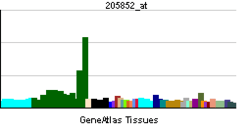CDK5R2
Cyclin-dependent kinase 5 activator 2 is an enzyme that in humans is encoded by the CDK5R2 gene.[1][2]
The protein encoded by this gene is a neuron-specific activator of CDK5 kinase. It associates with CDK5 to form an active kinase. This protein and neuron-specific CDK5 activator CDK5R1/p39NCK5A both share limited similarity to cyclins, and thus may define a distinct family of cyclin-dependent kinase activating proteins.[2]
Interactions
CDK5R2 has been shown to interact with Actinin, alpha 1.[3]
References
- ↑ Tang D, Yeung J, Lee KY, Matsushita M, Matsui H, Tomizawa K, Hatase O, Wang JH (Dec 1995). "An isoform of the neuronal cyclin-dependent kinase 5 (Cdk5) activator". J Biol Chem 270 (45): 26897–903. doi:10.1074/jbc.270.45.26897. PMID 7592934.
- ↑ 2.0 2.1 "Entrez Gene: CDK5R2 cyclin-dependent kinase 5, regulatory subunit 2 (p39)".
- ↑ Dhavan, Rani; Greer Paul L; Morabito Maria A; Orlando Lianna R; Tsai Li-Huei (Sep 2002). "The cyclin-dependent kinase 5 activators p35 and p39 interact with the alpha-subunit of Ca2+/calmodulin-dependent protein kinase II and alpha-actinin-1 in a calcium-dependent manner". J. Neurosci. (United States) 22 (18): 7879–91. PMID 12223541.
Further reading
- Humbert S, Dhavan R, Tsai L (2000). "p39 activates cdk5 in neurons, and is associated with the actin cytoskeleton.". J. Cell. Sci. 113 (6): 975–83. PMID 10683146.
- Humbert S, Lanier LM, Tsai LH (2001). "Synaptic localization of p39, a neuronal activator of cdk5.". Neuroreport 11 (10): 2213–6. doi:10.1097/00001756-200007140-00030. PMID 10923673.
- Muravenko OV, Gizatullin RZ, Protopopov AI et al. (2000). "Assignment of CDK5R2 coding for the cyclin-dependent kinase 5, regulatory subunit 2 (NCK5AI protein) to human chromosome band 2q35 by fluorescent in situ hybridization.". Cytogenet. Cell Genet. 89 (3-4): 160–1. doi:10.1159/000015602. PMID 10965112.
- Agarwal-Mawal A, Paudel HK (2001). "Neuronal Cdc2-like protein kinase (Cdk5/p25) is associated with protein phosphatase 1 and phosphorylates inhibitor-2.". J. Biol. Chem. 276 (26): 23712–8. doi:10.1074/jbc.M010002200. PMID 11320080.
- Patzke H, Tsai LH (2002). "Calpain-mediated cleavage of the cyclin-dependent kinase-5 activator p39 to p29.". J. Biol. Chem. 277 (10): 8054–60. doi:10.1074/jbc.M109645200. PMID 11784720.
- Dhavan R, Greer PL, Morabito MA et al. (2002). "The cyclin-dependent kinase 5 activators p35 and p39 interact with the alpha-subunit of Ca2+/calmodulin-dependent protein kinase II and alpha-actinin-1 in a calcium-dependent manner.". J. Neurosci. 22 (18): 7879–91. PMID 12223541.
- Strausberg RL, Feingold EA, Grouse LH et al. (2003). "Generation and initial analysis of more than 15,000 full-length human and mouse cDNA sequences.". Proc. Natl. Acad. Sci. U.S.A. 99 (26): 16899–903. doi:10.1073/pnas.242603899. PMC 139241. PMID 12477932.
- Sakashita G, Shima H, Komatsu M et al. (2004). "Regulation of type 1 protein phosphatase/inhibitor-2 complex by glycogen synthase kinase-3beta in intact cells.". J. Biochem. 133 (2): 165–71. doi:10.1093/jb/mvg020. PMID 12761178.
- Hillier LW, Graves TA, Fulton RS et al. (2005). "Generation and annotation of the DNA sequences of human chromosomes 2 and 4.". Nature 434 (7034): 724–31. doi:10.1038/nature03466. PMID 15815621.
- Rademakers R, Sleegers K, Theuns J et al. (2005). "Association of cyclin-dependent kinase 5 and neuronal activators p35 and p39 complex in early-onset Alzheimer's disease.". Neurobiol. Aging 26 (8): 1145–51. doi:10.1016/j.neurobiolaging.2004.10.003. PMID 15917097.
